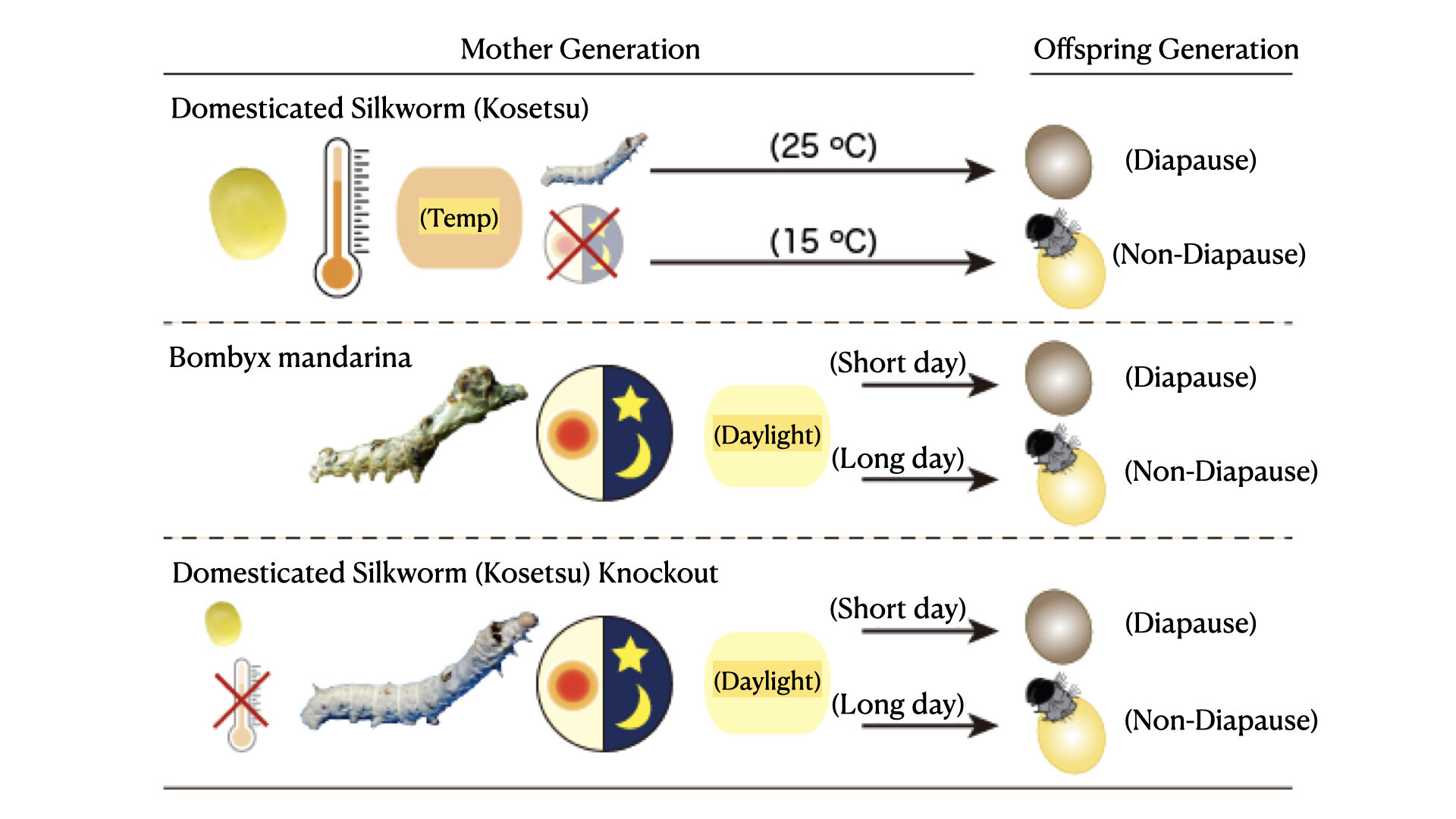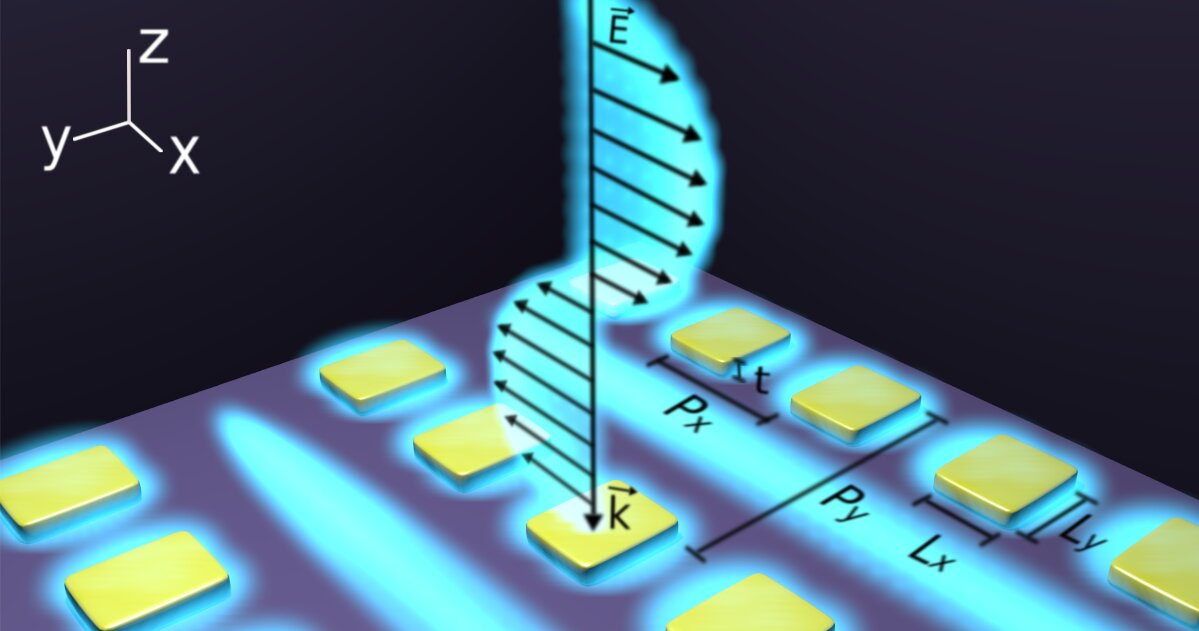#Silk moth’s diapause reverts back to ancestors’ through gene editing

“#Silk moth’s diapause reverts back to ancestors’ through gene editing”

Diapause is a phenomenon in which animals and insects foresee changes in the environment and actively reduce metabolism, or halt regular differentiation and development. It is an adaptation strategy for adverse environments such as surviving winters, but also to encourage uniform growth of the generational group.
By knocking out genes that allow the silkworm to detect temperature, researchers at Shinshu University found that the silk moth diapause changes from temperature to photoperiod, or day length. This is not only valuable as an elucidation of the molecular mechanism in the environmental response mechanism of organisms such as insects, but also a very important finding in exploring the process of domestication of silk moths. The production of dormant and non-diapausing eggs by artificially adjusting the environmental temperature has been widely used in the sericulture industry for more than 100 years.
In the Kosetsu type of the domesticated silk moth, adult females lay dormant eggs when exposed to 25 °C and non-diapausing eggs when exposed to 15 °C, respectively during their egg stage. It had been previously known that the temperature sensor, TRPA1, a type of temperature-sensitive protein found in humans and insects and detects 25 °C at the embryo stage, and as a result, a dormancy-inducing peptide hormone DH, is released. This hormone is produced in the cells of the subesophageal ganglion which is then released by a command from the brain to lay a dormant egg.
On the other hand, Bombyx mandarina, believed to be the ancestral species of the domesticated silk moth, Bombyx mori, which was domesticated between 10,000 and 5,000 years ago still inhabit the outdoor mulberry fields in East Asia and the Japanese archipelago, also diapauses during the egg period, but the temperature conditions during the embryonic stage of the mother are not related to diapause, and the photoperiod of the larval stage is followed. They lay non-diapause eggs under long-day conditions and dormant eggs under short-day conditions.
Professor Kunihiro Shiomi of the Faculty of Textile Science and Technology of Shinshu University and his research group found that the egg diapause of Bombyx mandarina is also induced by DH. The group also revealed that the temperature sensor TRPA1 that detects 25 °C are in the eggs of Bombyx mandarina.
How are the mechanisms for inducing dormancy between domesticated silk moths and Bombyx mandarina silkworms different? To elucidate it, Professor Shiomi created the KO lineage of her TRPA1 on the silk moth. Through this the group found that diapause is not determined by the temperature of the embryonic stage as in the case of Kosetsu silk moth without KO, but by the day length of the larval stage as in the case of Bombyx mandarina.
Artificial environmental temperature adjustment is easier than adjusting day length. Therefore, subspecies such as the Kosetsu-type, whose dormancy is determined by temperature, may have spread in the sericulture field during the process of artificial selection of domestication from Bombyx mandarina to silk moth.
So, how different are the mechanisms that induce dormancy different between domesticated silk moths and Bombyx mandarina? To investigate this, the group used genome editing technology (TALEN system) to create a KO strain of silk moth temperature sensors. It is thought that this type cannot detect temperature at the embryonic stage, which is involved in diapause induction, but it was found that the diapause is determined by the larval day length condition, similar to that of Bombyx mandarina. In other words, diapaused eggs were laid under short-day conditions, and non-diapause eggs were laid under long-day conditions.
Perhaps the wild-type Kosetsu has a strong link to temperature information and diapause induction, but in the KO-type this link is broken, similar to the ancestral silk moth. It is speculated that a photoperiod-dependent diapause determination mechanism happens during the larval stage. In addition, lineages that determine dormancy depending on temperature, such as the Kosetsu type, are easier to control artificially through temperature than the day length control in the process of domestication of silk moths from Bombyx mandarina. It is thought that it may have spread within the silk moth group during the selection process.
Silkworm’s brain determines diapause by thermal information
Takeshi Yokoyama et al, Comparisons in temperature and photoperiodic-dependent diapause induction between domestic and wild mulberry silkworms, Scientific Reports (2021). DOI: 10.1038/s41598-021-87590-4
Provided by
Shinshu University
Citation:
Silk moth’s diapause reverts back to ancestors’ through gene editing (2021, April 13)
retrieved 13 April 2021
from https://phys.org/news/2021-04-silk-moth-diapause-reverts-ancestors.html
This document is subject to copyright. Apart from any fair dealing for the purpose of private study or research, no
part may be reproduced without the written permission. The content is provided for information purposes only.
If you liked the article, do not forget to share it with your friends. Follow us on Google News too, click on the star and choose us from your favorites.
For forums sites go to Forum.BuradaBiliyorum.Com
If you want to read more Like this articles, you can visit our Science category.



